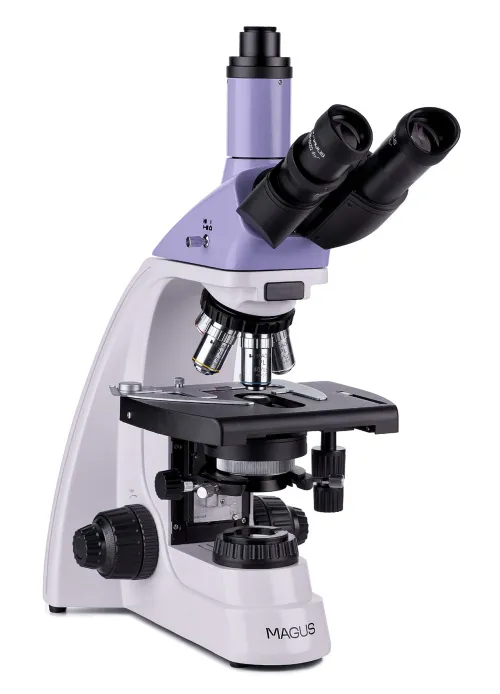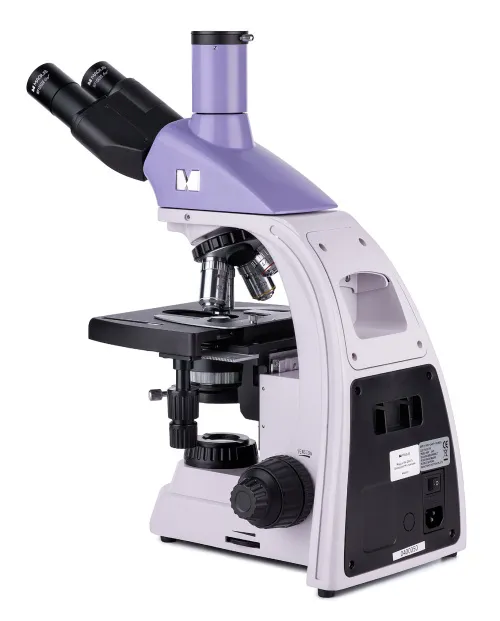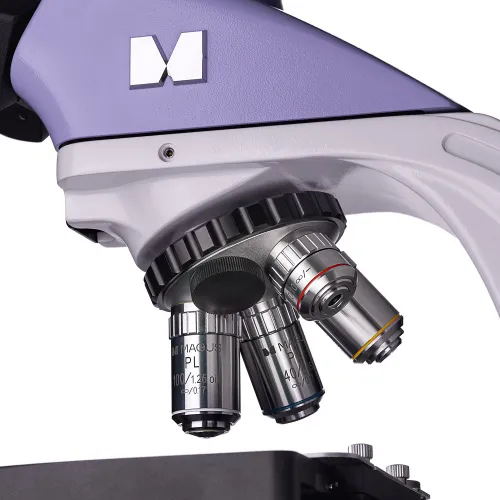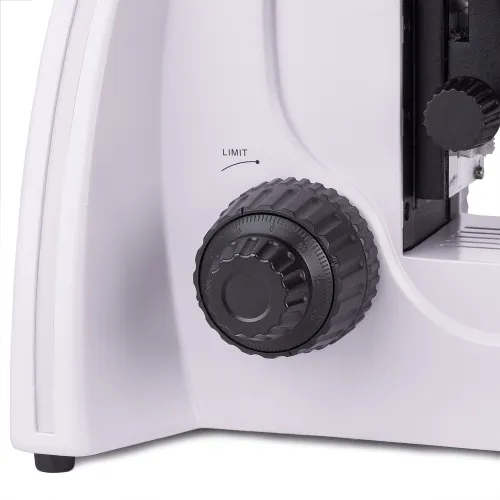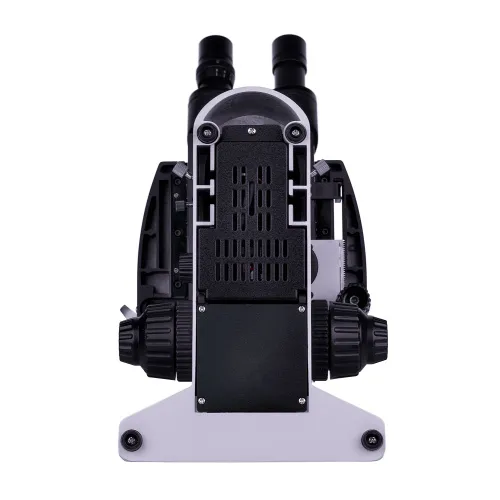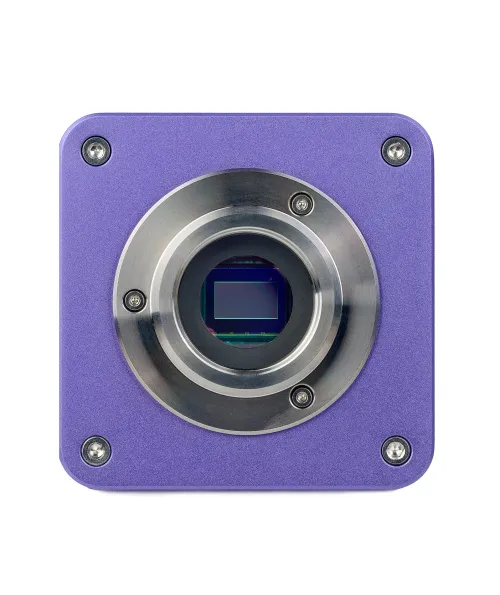MAGUS Bio D250TL Biological Digital Microscope
With a camera. Magnification: 40–1000x. Trinocular head, achromatic objectives, 3W LED
| Product ID | 83010 |
| Brand | MAGUS |
| Warranty | 5 years |
| EAN | 5905555018065 |
| Package size (LxWxH) | 43x27x63 cm |
| Shipping Weight | 11.1 kg |
The MAGUS Bio D250TL microscope studies thin sections and smears of biological samples. Observations are made using the brightfield microscopy technique in transmitted light. A 3-watt LED serves as the light source, and the optics feature infinity plan achromatic objectives. The microscope supports additional accessories, including darkfield, polarization, and phase contrast devices. This microscope is the ideal choice for laboratory analysis, research, and teaching.
Digital camera
Full color camera with SONY Exmor 2.1MP digital CMOS sensor. The sensor is manufactured using back-illumination technology to reduce light scattering and increase the matrix sensitivity (8935mV at 1/30s). The camera produces bright and clear images even in low light. Designed to work in darkfield and brightfield using objectives with a magnification of 40x, 60x, and 100x.
The camera can be mounted on a microscope in two ways: into the trinocular tube via a C-mount adapter or in place of the eyepiece in the tube using an adapter and adapter rings. It is recommended to use an adapter with a magnification from 0.6x to 0.9x with the camera, which will give the widest possible field of view without distortion. After installation, the camera connects to a computer via a USB3.0 port with a data transfer speed of 5Gbps.
Optics
The trinocular head includes two eyepiece tubes for observations and a vertical tube for mounting digital camera (not included). The tubes are 30° inclined for comfortable long working hours and can be rotated 360° to fit the height of the observer. There is a diopter adjustment ring that is located on the left tube.
Objectives are mounted in a 5-slot revolving nosepiece – four objectives are included, one slot for an additional objective is left free. Any optional objective can be installed in the free slot, allowing for additional magnification within the magnification range. The user can see the objective inserted into the optical path during the observation as the revolving nosepiece is oriented toward the interior. It keeps the space above the stage free.
The magnification range is from 40x to 1000x (only applies to the basic configuration). If you add additional objectives, the upper magnification limit will be increased.
Illumination
LEDs mounted at the bottom of the microscope provide bright and even illumination of the object. The color temperature remains the same when changing brightness. The power of the illumination is 3W. It has an operating life of 50,000 hours. The lighting system is powered by an AC power supply.
By adjusting the position of the Abbe condenser and opening or closing the aperture and field diaphragms, it is possible to set up the Köhler illumination. You can use sliders for darkfield and phase contrast techniques (a special slot is provided in the condenser). With the slider, switching between the research techniques is very fast.
Stage and focusing mechanism
The stage has no positioning rack. Therefore, it will not disturb you during observations, and the microscope itself will take up less space on the desktop. The mechanical attachment that moves the sample is removable (useful for manual scanning).
Coarse and fine focusing are used for focus adjustment. The knobs are located on both sides. As they are located closer to the base, you do not have to hold your hands in the air while working. You can relax them on the table. The coarse focusing has a lock knob and tension adjustment. The focus adjustment is smooth and effortless.
Accessories
The capabilities of the MAGUS Bio D250TL microscope can be enhanced with the line of accessories, including eyepieces, objectives, calibration slides, digital cameras, darkfield, polarization, and phase contrast devices.
Key features of the microscope:
- Trinocular head, revolving nosepiece for 5 objectives, infinity plan achromatic optics
- The eyepiece tubes rotate 360° for easy adjustment to fit the height of the observer
- There is a diopter adjustment ring on the left tube, coarse and fine focusing
- The coarse focusing has a lock knob and tension adjustment
- The Abbe condenser is centered and height-adjustable, and the field and aperture diaphragms allow for the Köhler illumination setup
- Transmitted light source – 3W LED with adjustable brightness, powered by 220V power supply
- Option to install additional accessories
Key features of the camera:
- 2.1'' backlit CMOS sensor, high matrix sensitivity
- Suitable for darkfield or brightfield studies with 40x, 60x, and 100x objectives
- Installed into the trinocular tube or in the eyepiece tube of a microscope
- Full HD resolution 1920x1080px with a frame rate of 96fps, perfect for studying moving objects
- Connection to PC via USB3.0 port, data transfer speed 5Gbps
- Software and drivers included
The kit includes:
- MAGUS CDF50 Digital Camera (digital camera, USB cable, installation CD with drivers and software, user manual and warranty card)
- Base with a power input, transmitted light source, focusing mechanism, stage, condenser mount, and revolving nosepiece
- Abbe condenser
- Trinocular head
- Infinity plan achromatic objective: 4x/0.10
- Infinity plan achromatic objective: 10x/0.25
- Infinity plan achromatic objective: 40x/0.65 (spring-loaded)
- Infinity plan achromatic objective: 100x/1.25 oil (spring-loaded)
- Eyepiece 10x/22mm with a long eye relief (2 pcs.)
- Eyecup (2 pcs.)
- Filter (4 pcs.)
- C-mount camera adapter
- Bottle of the immersion oil
- AC power cord
- Dust cover
- User manual and warranty card
Available on request:
- 10x/22mm eyepiece with scale
- 12.5x/14mm eyepiece (2 pcs.)
- 15x/15mm eyepiece (2 pcs.)
- 20x/12mm eyepiece (2 pcs.)
- 25x/9mm eyepiece (2 pcs.)
- Infinity plan achromatic objective: 20x/0.40
- Infinity plan achromatic objective: 60x/0.80 (spring-loaded)
- Phase-contrast device
- Phase slider
- Darkfield condenser NA 0.9
- Oil darkfield condenser NA 1.36–1.25
- Darkfield slider
- Polarization devices
- Calibration slide
- LCD Monitor
| Product ID | 83010 |
| Brand | MAGUS |
| Warranty | 5 years |
| EAN | 5905555018065 |
| Package size (LxWxH) | 43x27x63 cm |
| Shipping Weight | 11.1 kg |
| Microscope specifications | |
| Type | biological, light/optical, digital |
| Microscope head type | trinocular |
| Head | Gemel head (Siedentopf, 360° rotation) |
| Head inclination angle | 30 ° |
| Magnification, x | 40 — 1000 |
| Magnification, x (optional) | 40–1200/1250/1500/1600/2000/2500 |
| Eyepiece tube diameter, mm | 30 |
| Eyepieces | 10х/22mm, eye relief: 10mm (*optional: 10x/22mm with scale, 12.5x/14; 15x/15; 20x/12; 25x/9) |
| Objectives | infinity plan achromatic: 4x/0.10; 10x/0.25; 40xs/0.65; 100xs/1.25 (oil); parfocal distance: 45mm (*optional: 20x/0.40; 60хs/0.80) |
| Revolving nosepiece | for 5 objectives |
| Working distance, mm | 21 (4x); 5 (10x); 0.66 (40xs); 0.36 (100xs); 8.8 (20x); 0.465 (60xs) |
| Interpupillary distance, mm | 48 — 75 |
| Stage, mm | 180x150 |
| Stage moving range, mm | 75/50 |
| Stage features | two-axis mechanical stage, without a positioning rack |
| Eyepiece diopter adjustment, diopters | ±5 (on the left tube) |
| Condenser | Abbe condenser, N.A. 1.25, center-adjustable, height-adjustable, adjustable aperture diaphragm, a slot for a darkfield slider and phase contrast slider, dovetail mount |
| Diaphragm | adjustable aperture diaphragm, adjustable iris field diaphragm |
| Focus | coaxial, coarse focusing (21mm, 39.8mm/circle, with a lock knob and tension adjusting knob) and fine focusing (0.002mm) |
| Illumination | LED |
| Brightness adjustment | ✓ |
| Power supply | 220±22V, 50Hz, AC network |
| Light source type | 3W LED |
| Light filters | yes |
| Operating temperature range, °C | 5...+35 |
| Ability to connect additional equipment | phase contrast device (condenser and objectives), darkfield condenser (dry or oil), polarization devices (polarizer and analyzer) |
| User level | experienced users, professionals |
| Assembly and installation difficulty level | complicated |
| Application | laboratory/medical |
| Illumination location | lower |
| Research method | bright field |
| Pouch/case/bag in set | dust cover |
| Weight, kg | 8 |
| Dimensions, mm | 200x436x400 |
| Camera specifications | |
| Sensor | SONY Exmor CMOS |
| Color/monochrome | color |
| Megapixels | 2.1 |
| Maximum resolution, pix | 1920x1080 |
| Sensor size | 1/1.2'' (11.14x6.26mm) |
| Pixel size, μm | 5.8x5.8 |
| Light sensitivity | 8935mV with 1/30s |
| Signal/noise ratio | 0.6mV with 1/30s |
| Exposure time | 0.014ms–15s |
| Video recording | ✓ |
| Frame rate, fps at resolution | 96@1920x1080 |
| Place of installation | trinocular tube, eyepiece tube instead of an eyepiece |
| Image format | *.jpg, *.bmp, *.png, *.tif |
| Video format | output: *.wmv, *.avi, *.h264 (Windows 8 and later), *h265 (Windows 10 and later) |
| Spectral range, nm | 380–650 (built-in IR filter) |
| Shutter type | ERS (electronic rolling shutter) |
| White balance | automatic, manual |
| Exposure control | automatic, manual |
| Software features | brightness, exposure time, image size |
| Software | MAGUS View |
| Output | 5Gb/s, USB 3.0 |
| System requirements | Windows 8/10/11 (32bit and 64bit), Mac OS X, Linux, up to 2.8GHz Intel Core 2 or higher, minimum 2GB RAM, USB 3.0 port, CD-ROM, 17" or larger display |
| Mount type | C-mount |
| Body | CNC aluminum alloy |
| Camera power supply | DC, 5V, from computer USB port; a 12V, 3A adapter for Peltier element |
| Camera operating temperature range, °С | -10...+50 |
| Operating humidity range, % | 30 — 80 |
and downloads
We have gathered answers to the most frequently asked questions to help you sort things out
Find out why studying eyes under a microscope is entertaining; how insects’ and arachnids’ eyes differ and what the best way is to observe such an interesting specimen
Read this review to learn how to observe human hair, what different hair looks like under a microscope and what magnification is required for observations
Learn what a numerical aperture is and how to choose a suitable objective lens for your microscope here
Learn what a spider looks like under microscope, when the best time is to take photos of it, how to study it properly at magnification and more interesting facts about observing insects and arachnids
This review for beginner explorers of the micro world introduces you to the optical, illuminating and mechanical parts of a microscope and their functions
Short article about Paramecium caudatum - a microorganism that is interesting to observe through any microscope





